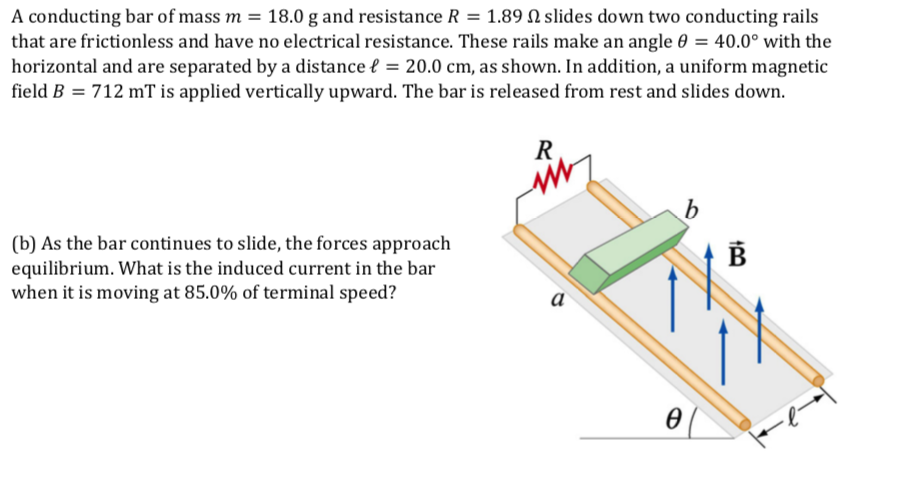A conducting bar of mass m = 18.0 g and resistance R = 1.89 N slides down two conducting rails that are frictionless and have no electrical resistance. These rails make an angle 0 = 40.0° with the horizontal and are separated by a distance l = 20.0 cm, as shown. In addition, a uniform magnetic field B = 712 mT is applied vertically upward. The bar is released from rest and slides down. R in (b) As the bar continues to slide, the forces approach equilibrium. What is the induced current in the bar when it is moving at 85.0% of terminal speed? a
A conducting bar of mass m = 18.0 g and resistance R = 1.89 N slides down two conducting rails that are frictionless and have no electrical resistance. These rails make an angle 0 = 40.0° with the horizontal and are separated by a distance l = 20.0 cm, as shown. In addition, a uniform magnetic field B = 712 mT is applied vertically upward. The bar is released from rest and slides down. R in (b) As the bar continues to slide, the forces approach equilibrium. What is the induced current in the bar when it is moving at 85.0% of terminal speed? a
Chapter12: Sources Of Magnetic Fields
Section: Chapter Questions
Problem 25P: A long, straight, horizontal wire carries a left-to-right current of 20 A. If the wire is placed in...
Related questions
Question
Please just answer this question: Qualitatively discuss what effect considering the resistance of the
(Note if it helps: I calculated an induced current of 0.049A for part b).

Transcribed Image Text:A conducting bar of mass m = 18.0 g and resistance R = 1.89 N slides down two conducting rails
that are frictionless and have no electrical resistance. These rails make an angle 0 = 40.0° with the
horizontal and are separated by a distance l = 20.0 cm, as shown. In addition, a uniform magnetic
field B = 712 mT is applied vertically upward. The bar is released from rest and slides down.
R
in
(b) As the bar continues to slide, the forces approach
equilibrium. What is the induced current in the bar
when it is moving at 85.0% of terminal speed?
B
a
0 (
Expert Solution
This question has been solved!
Explore an expertly crafted, step-by-step solution for a thorough understanding of key concepts.
This is a popular solution!
Trending now
This is a popular solution!
Step by step
Solved in 2 steps with 2 images

Knowledge Booster
Learn more about
Need a deep-dive on the concept behind this application? Look no further. Learn more about this topic, physics and related others by exploring similar questions and additional content below.Recommended textbooks for you


Principles of Physics: A Calculus-Based Text
Physics
ISBN:
9781133104261
Author:
Raymond A. Serway, John W. Jewett
Publisher:
Cengage Learning

College Physics
Physics
ISBN:
9781285737027
Author:
Raymond A. Serway, Chris Vuille
Publisher:
Cengage Learning


Principles of Physics: A Calculus-Based Text
Physics
ISBN:
9781133104261
Author:
Raymond A. Serway, John W. Jewett
Publisher:
Cengage Learning

College Physics
Physics
ISBN:
9781285737027
Author:
Raymond A. Serway, Chris Vuille
Publisher:
Cengage Learning

College Physics
Physics
ISBN:
9781305952300
Author:
Raymond A. Serway, Chris Vuille
Publisher:
Cengage Learning

Physics for Scientists and Engineers: Foundations…
Physics
ISBN:
9781133939146
Author:
Katz, Debora M.
Publisher:
Cengage Learning

Physics for Scientists and Engineers, Technology …
Physics
ISBN:
9781305116399
Author:
Raymond A. Serway, John W. Jewett
Publisher:
Cengage Learning